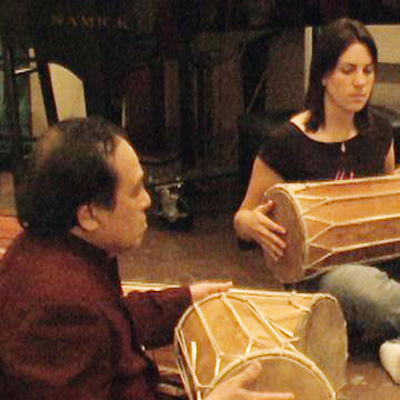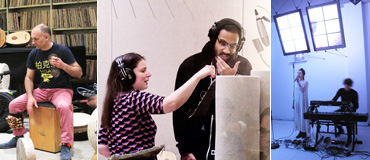
I Wayan Sinti
I Wayan Sinti was born January 1, 1943 in the village of Banjar Dauh, Ubung Kaja, near Denpasar on the Island of Bali. He is the son of the late Mangku Ketut Sadra and Ni Made Rumik. He began his study of Balinese vocal and instrumental music in his village in 1957, because his parents could not afford to send him to government school. However, in 1961, he was accepted to the new high school for the performing arts, KOKAR, which had recently opened in Denpasar. He graduated from KOKAR in 1964 and was appointed a teaching position there because he graduated at the top of his class.
Pak Sinti has mastered many kinds of Balinese vocal music and nearly all forms of instrumental music with outstanding teachers such as, I Nyoman Gerana, Ida Peadanda Made Sideman, I Nyoman Kaler, and I Wayan Lotring. His dedication to the classical musical styles he learned from these teachers inspired him to revive many forms of gamelan including gamelan gambang, selonding, saron, gong luang, gambuh, semar pegulingan, legong, bebarongan, and others.
Pak Sinti has spread his love of Balinese music by teaching village ensembles throughout Bali, composing in both the classical and contemporary genres, and serving as a senior spokesman for the Balinese performing arts. Most significantly, during his four decades as an instructor at KOKAR, where he taught the next generation of Balinese musicians, his influence as a teacher, performer and composer is now almost everywhere apparent in Bali. His deep dedication to the arts has been officially recognized through awards presented to him by the mayor of Denpasar, the governor of Bali, and the president of Indonesia. He is also known worldwide for his compositions for gamelan in genres such as gong kebyar, gong gede, pelegongan, semar pegulingan, beleganur and also various vocal genres.
In 1974, Pak Sinti was invited to teach at the Center for World Music in Berkley, CA were he spent 2 ½ months teaching various forms of Balinese music. In 1978 he returned to the U.S. for four years to study ethnomusicology and teach Balinese music at San Diego State University, where he graduated with an MA in music. In 1985 he again returned to the U.S., this time to train the American gamelan Sekar Jaya for their performance in Bali as the first foreign gamelan to perform in at the Bali arts festival. His relationship with Sekar Jaya continued in 1996 when he spent ten months in San Francisco composing music for their performance of the Ramayana in collaboration with Abinaya South Indian Dance.
In 1994, Pak Sinti created a new type of gamelan ensemble called Manikasanti, which means “jewel for peace.” Manikasanti features a new tuning system that allows for the playing of various Balinese modes and musical scales, and was inspired by his long study of ritual vocal and instrumental music.
Pak Sinti produced several recordings at Jack Straw as part of a 2004 residency in the Artist Support Program, while in residency as a visiting artist at the University of Washington School of Music, where he taught Balinese vocal and gamelan music. During his time at the University of Washington he also created a new form of gamelan called Siwa Nada, which was constructed with the help of his students. Read more about this project and see images of the instruments at the UW Ethnomusicology Musical Instrument collection online.
Artist Support Program 2004: Record compositions for a chamber ensemble of suling (bamboo flute), rebab (spike fiddle), and kendang (drum).




